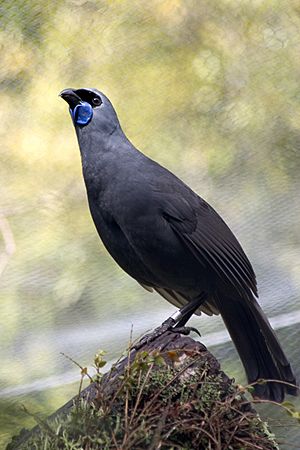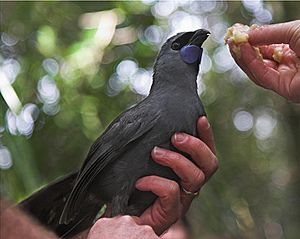Kōkako facts for kids
Quick facts for kids Kōkako |
|
|---|---|
 |
|
| Scientific classification |
|
| Kingdom: | Animalia |
| Phylum: | Chordata |
| Class: | Aves |
| Order: | Passeriformes |
| Family: | Callaeidae |
| Genus: | Callaeas J.R. Forster, 1788 |
| Species | |
The kōkako are two types of special forest birds. They are found only in New Zealand and are currently endangered. These birds are the North Island kōkako (Callaeas wilsoni) and the South Island kōkako (Callaeas cinereus). Sadly, the South Island kōkako is thought to be extinct.
Both kōkako species are mostly slate-grey. They have black masks around their eyes and fleshy flaps of skin called wattles near their beaks. Kōkako belong to a group of five New Zealand wattlebirds. The other three are two types of tieke (also called saddlebacks) and the extinct huia.
Long ago, kōkako were common all over New Zealand. But their numbers have dropped a lot. This is mainly because of animals brought to New Zealand by humans, like possums, stoats, cats, and rats. These animals hunt kōkako. In the past, people sometimes called the kōkako the New Zealand crow. However, it's not a crow at all, even if it looks a bit like one from far away.
Sometimes, you might see the name kokako written without the special mark over the 'o'. This is common in New Zealand English.
Contents
What is a Kōkako?
The kōkako is a very old type of songbird from New Zealand. It is one of five unique New Zealand wattlebirds. The others are two kinds of tieke (saddleback), which are also endangered, and the huia, which is now extinct. These New Zealand wattlebirds are not closely related to any other birds in the world, except for the stitchbird. Scientists are still trying to figure out their exact family tree.
How to Spot a Kōkako
The North Island kōkako, Callaeas wilsoni, has bright blue wattles. When they are young, their wattles are actually a light pink colour, and they turn blue as the bird gets older.
The South Island kōkako, Callaeas cinereus, is different. Its wattles are mostly orange. It only has a small patch of blue right at the bottom of its wattles.
Kōkako Behaviour and Diet
The kōkako is famous for its beautiful, clear song. It sounds a bit like an organ playing. Its call is so loud that it can be heard for several kilometres! Kōkako pairs sing together in a bell-like duet. They often sing for up to an hour in the early morning. Interestingly, kōkako groups in different parts of the North Island have their own unique songs. We don't know if any South Island kōkako are left.
Kōkako are not very good at flying. They rarely fly more than 100 metres at a time. Their wings are quite short and rounded. Instead of flying, they prefer to hop and leap from branch to branch using their strong grey legs. When they do move between trees, they usually climb up a tall tree first. These are often New Zealand podocarp trees like rimu and matai. Then, they glide to another nearby tree. People have compared their way of moving to a flying squirrel.
Kōkako eat a variety of foods. Their diet includes leaves, fern fronds, flowers, fruits, and small insects.
Kōkako and People
Kōkako in Māori Culture
Māori myths tell several stories about the kōkako. In one well-known story, the kōkako helped the hero Māui. Māui was fighting the sun and became very thirsty. The kōkako filled its plump wattles with water and offered it to Māui. To thank the kōkako for its kindness, Māui stretched its legs. This made them lean, long, and strong. This way, the kōkako could easily leap through the forest to find food.
The kōkako is also featured on the back of the New Zealand $50 note.



